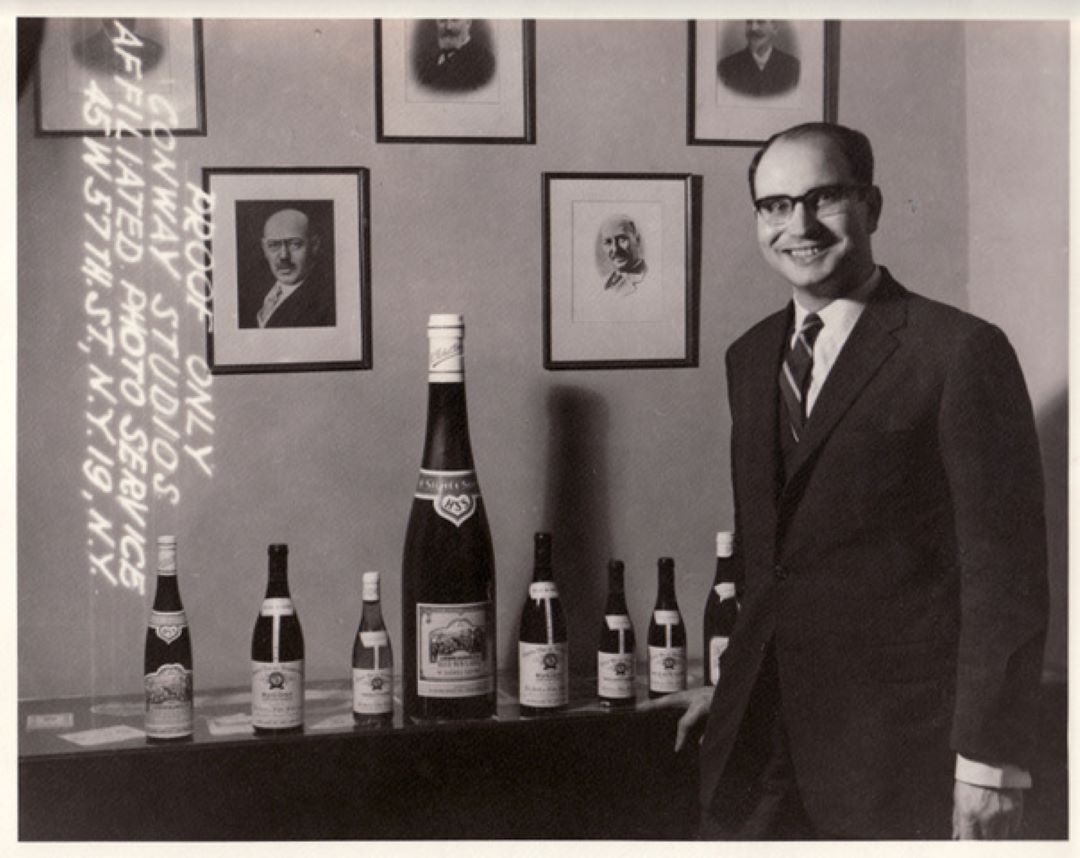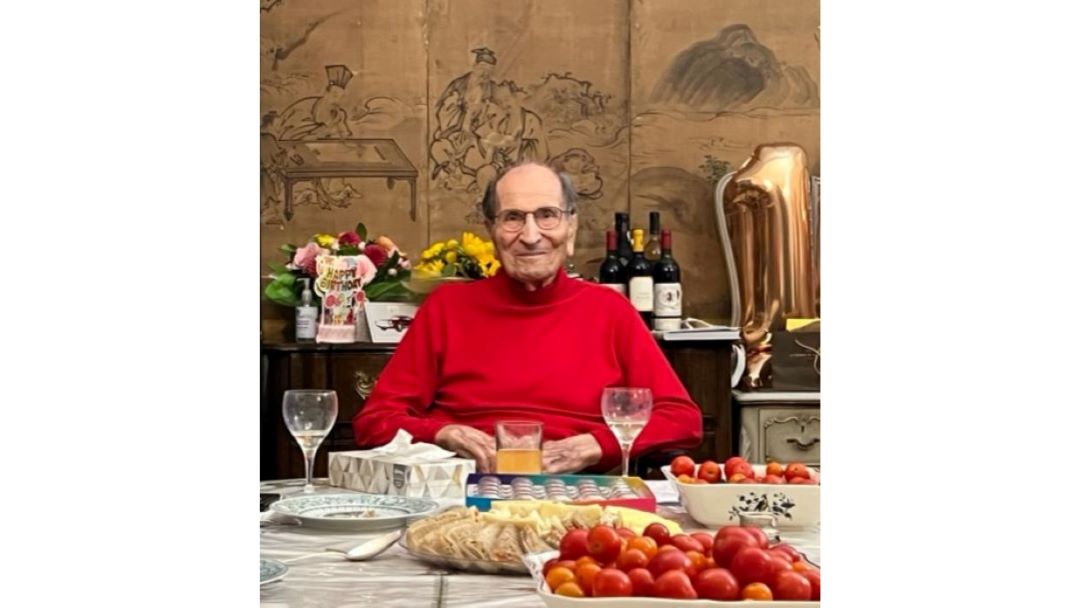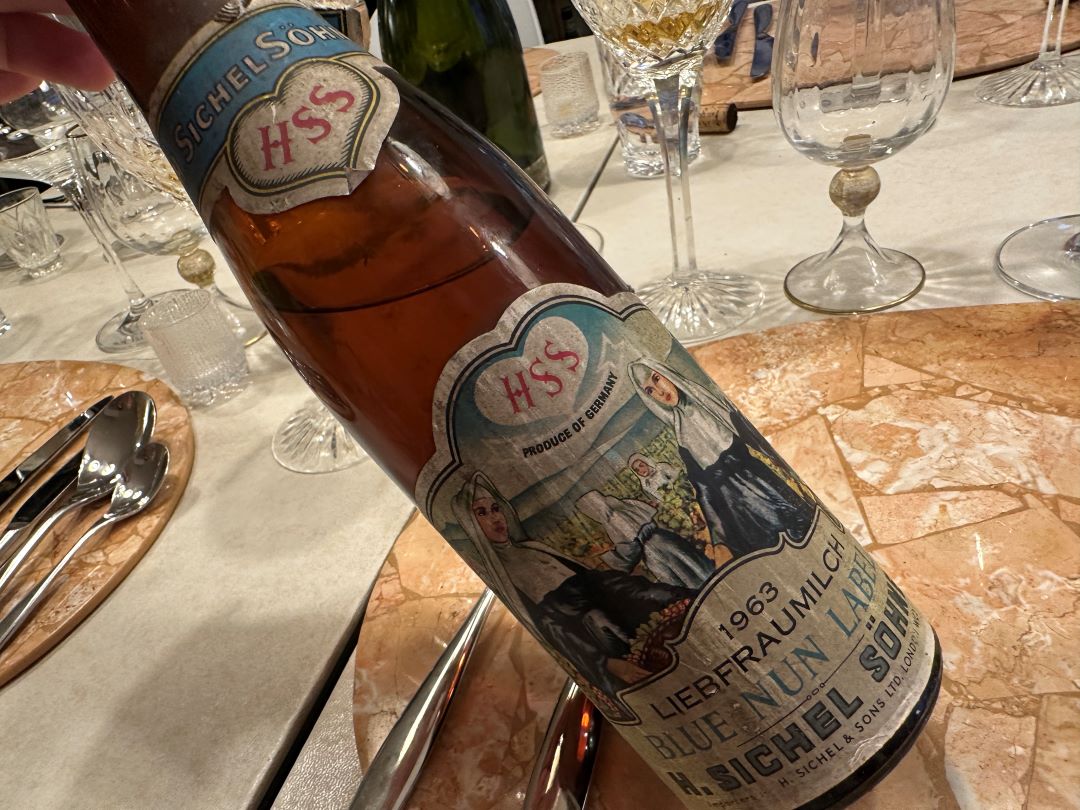Browse using the new Vinous website now. Launch →
Printed by, and for the sole use of . All rights reserved © 2015 Vinous Media
Blue Nun: The Wine at the Center of Everything
BY NEAL MARTIN | JULY 15, 2025
No other bottle has been a wellspring for so many tales. No other brand has permeated culture like the star of this article.
Ladies and gentlemen, Blue Nun.
I know what you are thinking. There he goes again. Those Brits and their irony. A bit of whimsy, comic relief. Why invest words in a wine that has been the butt of countless jokes for years. A vinous totem for someone who is bereft of a discerning palate, one helplessly marooned in the seventies.
Au contraire. By the end of this article, you will be as glad to have read it as I was to write, not that it will entice you to cancel your allocation from Egon Müller and replace it with Blue Nun. That is not my intention. However, let the court state for the record that this bottle incited more remarks and responses than any other this year.
So why?
Well, this
was not any old bottle of Blue Nun. No, this was a 1963 Blue Nun, surely the
last survivor of millions that trundled off the bottling line. That year is infamous
for its dire quality of wine—Vintage Port excepted—however, little did I know
that 1963 was in fact a fine growing season in Germany.
So, how did this bottle come my way?
It was poured at a private dinner in West London that included the likes of 1973 Dom Pérignon and a 1958 Bartolo Mascarello Barolo. This was certainly not a shabby evening. It was during these gems that the bottle of Blue Nun graced us with her holy presence. Our host announced this bottle had been waiting for the right moment. He had been an acquaintance of the late Peter Sichel, the “father” of Blue Nun. However, the bottle did not come from Sichel, but rather in all likelihood from the cellar of my former colleague, Josh Raynolds. Thinking about Josh’s wry humour, it would not surprise me. I like to think that he was saving it to pour blind at some Vinous dinner with a twinkle in his eye.
As the “Liebfraumilch über alles” pours into my startled glass, I admit noting that the retro label is exquisite with its ornately sketched quartet of nuns in the vines resplendent in their veils and habits. Why blue, not black? The original labels came out miscoloured, and instead of demanding another print run, Sichel took a liking to the unorthodox hue. He not only kept it but redrew the nuns to make them more youthful and come-hither. It was an act of marketing genius.
Ah, the late Peter Max Sichel. If you think you have had a remarkable life, it is nothing compared to this man. Born in Mainz in 1922, Sichel died on February 25, 2025 at the ripe old age of 102. “Peter had a great sense of humour,” our host tells me later via e-mail. “He had a very good knowledge of wine and bicycled around New York well into his 80s. He was also a particularly good raconteur.”
I urge you to read the obituaries following his death or Sichel’s autobiography, “The Secrets of My Life.” To adumbrate his storied time on Earth, Sichel came from a large secular Jewish family. He was the first German student to attend Stowe private school in England. Sichel was interned with his sister in a camp in France, as they were considered “enemy aliens” as German troops invaded Poland. They escaped the camp and crossed the Pyrenees on foot, bribed a border guard with a fountain pen to gain passage to New York, used Sichel’s fluent French and German to play a crucial role in the American intelligence service, trained Algerian guerrillas for the French Resistance, conducted post-war espionage missions in Berlin against Russia, led the C.I.A.’s Eastern European operations, monitored communist China from Hong Kong, and was the target of an FBI investigation as a possible KGB mole in 1955. Disillusioned, Sichel left the intelligence service in 1960, whereupon he joined the family’s wine merchant business.
This is all before Blue Nun.
Nowadays, we look down our noses at the name “Blue Nun,” but this most famous brand of Liebfraumilch was instrumental in destigmatising wine, hitherto the preserve of the middle and upper classes. In terms of impact, in terms of democratisation and changing attitudes towards wine, Sichel should be mentioned in the same breath as Baron Philippe de Rothschild, Robert Mondavi, David Hohnen of Cloudy Bay or Robert Parker. “My father was determined to teach Americans to appreciate wine,” Sichel’s daughter, Bettina, tells me from Sonoma, where she co-owns Laurel Glen Vineyard. “I heard him tell the story many times that when he moved to Washington, D.C. in the 1950s with the CIA and started attending dinner parties, he was shocked to see that the educated people with whom he socialised only drank cocktails—before and during the meal. Blue Nun was just one of his efforts to get Americans drinking wine. He also helped found the Commanderie de Bordeaux.”
In 2020, my knowledgeable colleague Anne Krebiehl, MW, composed an illuminating history of Liebfraumilch from its medieval origin around the German town of Worms, when it was known as “Our Dear Lady’s Milk.” Over years it became a Phantasiename, and the laws with respect to its use were diluted to the extent that unscrupulous winemakers could essentially use underripe grapes and add excessive amounts of sugar to make the wine palatable to the proles.
Peter Sichel was not the inventor of Blue Nun. The brand had existed within the Sichel family company’s portfolio since 1923, when the 1921 vintage hit the shelves. According to writer Bruce Palling, Blue Nun was “…the generic name for ten of the company’s different white wines produced in Germany, which sold 10,000 cases throughout the world.” Around 1,000 of those were in the U.K. during the 1930s. Sichel turned Blue Nun into the first global wine brand, enjoyed by everyone from those taking their first baby steps into wine to famous pop stars. A bottle was standing atop a Leslie speaker as Paul McCartney played an organ in George Harrison’s “Long, Long, Long” during the recording session for “The White Album.” The bottle rattled whenever McCartney played a particular chord at the end of the song, and the sound remains in the final mix. Beatles authority Ian McDonald ranks this as one of the Fab Four’s greatest moments. Hey, you remember when the Sex Pistols outraged an entire nation when they uttered rude words on the Bill Grundy teatime show? Guess which two bottles of wine guitarist Steve Jones glugged before airing? Clue, it was not Egon Müller.

Peter Sichel with his favourite tipple, pictured in the 1960s.
Growing up in Essex, Blue Nun was about the only wine that my parents bought. Mum abstained. Dad would share a glass with Uncle Alf, the pair finishing off the bottle as they did the washing up. Blue Nun was ubiquitous. It was a safe choice for the many who simply wanted to drink something they recognised.
But did the Sichel family themselves drink it?
“Blue Nun could often be found on our dinner table and was served at all my parents’ parties, usually as an apéritif, at least until the latter part of the 1970s,” Bettina Sichel told me. She added, “I have certainly consumed quite a bit of Blue Nun in my time. I am pretty sure it is the first wine I ever had. The generous supply of Blue Nun my dad provided me during my college years certainly added to my popularity!”
By the 1980s, Blue Nun was shipping 24 million bottles per year to over 90 countries thanks to Sichel’s marketing nous. Take a look at this advertisement from 1979 that infers that Blue Nun makes you irresistible to women. Blue Nun was ingeniously touted as a wine that was, to quote the tagline, “correct with any dish,” as seen in this commercial. Many of the ads in the United States featured real-life husband-and-wife comedians Jerry Stiller (father of actor Ben Stiller) and Anne Meara.

This photo was sent by vintner Jeff Morgan to Bettina Sichel. Morgan’s mother was the agent for Jerry Stiller and Anne Meara. Meara is pictured at left, pouring what looks like a magnum of Blue Nun for Morgan’s mother.
This success could not last. Usurped by Australian and Californian brands and a burgeoning consumer interest in wine designated by grape variety, Blue Nun became passé, a bit naff. Ergo, Steve Coogan (playing Alan Partridge) used it during a memorable restaurant scene with TV commissioner Tony Hayers pleading for his talk show to be recommissioned. Interestingly, during their comical exchange, Hayers remarks that wine is “no longer elitist,” something that can be attributed to Blue Nun. Partridge then orders a half-bottle, and I noted that its mere mention elicited an audience laugh…
Partridge was to daytime TV presenters what Blue Nun had become to wine.
Blue Nun also inspired a song by the Beastie Boys, who sampled Peter Sichel extolling its virtues. Sichel later quipped that the song made him more famous than the wine itself. It was around this time that I met the corporeal Blue Nun. Attending my first Vinexpo in Bordeaux with Japanese colleagues, down the aisle walked a young woman dressed in that unmistakable blue habit, pouring her namesake wine. I nudged my friend and exclaimed, “Look! It’s the blue nun.” She looked self-conscious, doubtlessly wondering how she ended up like this instead of on a Parisian catwalk. We took a couple of glasses in sympathy.
Contrary to what some believe, Blue Nun is still available, though Sichel sold the brand to another German company, F.W. Langguth Erben, who updated the label and introduced new cuvées, including a “Blue Nun Sparkling Gold Edition” with actual 24-carat gold flakes floating inside. You don’t get that in a bottle of Montrachet. It is still one of the best-selling kosher wines, huge in Israel. Mischievously, I served a bottle to unsuspecting guests at a wine dinner four years ago themed around bottles that signposted my life. They got the joke. In fact, the 1999 Richebourg from DRC was marginally corked, prompting me to quip that you could argue that on this night, Blue Nun was superior.
Back to the bottle of 1963. I am not going to claim it is close to the greatest Riesling ever produced. That said, I have drunk a lot worse. Exactly what constituted this wine is not known. Krebiehl’s piece implies that the fruit would have been a mixture of Riesling, Sylvaner or Müller-Thurgau, sourced from any region in the Rhine, with multitudinous lots blended in to retain consistency. Delivering dried honey and lanolin on the nose, the 1963 was simple but unequivocally not malodorous, with no oxidation or maderisation after six decades. That is remarkable in itself. The palate did feel unnaturally sweet, curiously unevolved given the passage of time, as if preserved in aspic by the Süssreserve. We laughed. We clinked glasses. We moved on to finer fare. Yet over the following days, it was this bottle that I could not get out of my mind.
Jeopardy quiz…
“This wine connects Nazis, Cold War espionage, The Beatles, the KGB, the Sex Pistols, Alan Partridge, Ben Stiller and The Beastie Boys.”
Answer: What is Blue Nun, the wine at the centre of everything?

Bettina Sichel sent me this photo of her father celebrating his 100th birthday.
Thanks to Stuart Leaf, Bettina Sichel, Bruce Palling and Anne Krebiehl, MW for help writing this article.
© 2025, Vinous. No portion of this article may be copied, shared or re-distributed without prior consent from Vinous. Doing so is not only a violation of our copyright, but also threatens the survival of independent wine criticism.
You Might Also Enjoy
2023 Mosel-Saar-Ruwer: A Riesling Race Against Rain, Anne Krebiehl, MW, December 2024
Rheinhessen & Rheingau: Riesling Triumphs After Rain, Anne Krebiehl, MW, October 2024
Nahe, Pfalz & Mittelrhein–Of Wheat, Chaff and Thrill, Anne Krebiehl, MW, September 2024
2022 Mosel-Saar-Ruwer: Old Vines and Steep Challenges, Anne Krebiehl, MW, October 2023
2022 Rheinhessen & Nahe: Rain in the Nick of Time, Anne Krebiehl, MW, September 2023
The Wines That Shaped My Life, Neal Martin, March 2022

